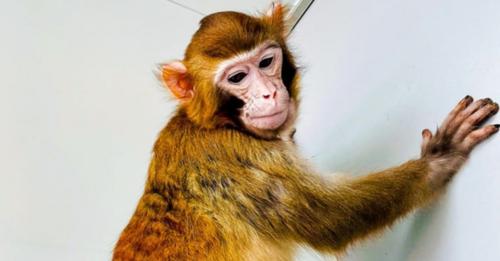
China’s first cloned rhesus monkey lived for over two years, marking the longest-living rhesus macaque. In contrast, previous cloning attempts yielded specimens with no live births or with offspring dying within hours. The Chinese Academy of Sciences announced that the Retro monkey is healthy and growing stronger daily.
Most think of white lab rats when they hear “animal testing,” but scientists also experiment with rhesus monkeys. Their physiological similarities to humans make them excellent test subjects, but they may become extinct if we continue experimenting with them. Fortunately, cloning could help provide a more sustainable supply of test subjects.
This article will explain how China created the longest-living rhesus monkey clone and its implications. Later, I will discuss its other monkey experiment.
How did China create its Rhesus monkey clone?

CNN shared the story of the Rhesus monkey clone. A Chinese research team from Shanghai and Beijing used a modified version of somatic cell nuclear transfer on cynomolgus monkeys (Macaca fascicularis).
Then, they adjusted their methods to clone a rhesus monkey (Macaca mulatta). Hundreds of failed cloning attempts revealed that early cloned embryos did not develop properly.
They used inner cell mass transplantation to address this problem. It involves putting cloned inner cells into a non-cloned embryo, allowing the clone to develop normally.
Later, the researchers tested the new approach using 113 reconstructed embryos. Next, they transferred 11 to seven surrogates, which resulted in only one live birth.
“We have achieved the first live and healthy cloned rhesus monkey, which is a big step forward that has turned impossible to possible, although the efficiency is very low compared to normal fertilized embryos,” says research investigator Falong Lu.
A National Academies of Sciences, Engineering, and Medicine report said research on nonhuman primates is essential for medical advances, such as COVID-19 vaccine development.
That is why Chinese Academy of Science principal investigator Miguel Esteban said producing genetically identical monkeys could be useful.
“This research is proof of principle that cloning can be done in different non-human primate species and opens the door to new ways of enhancing efficiency. Cloned monkeys can be genetically engineered in complex ways that wild-type monkeys cannot; this has many implications for disease modeling,” he added.
In contrast, the United Kingdom’s Royal Society for Prevention of Cruelty to Animals opposes this research. They said it has “serious ethical and welfare concerns around the application of cloning technology to animals.”
“Cloning animals requires procedures that can cause pain and distress, and there can be high failure and mortality rates,” the institution added.
How did China create a chimera monkey?
China grows first-ever fluorescent-green chimera monkey using stem cells https://t.co/rU97Lzulb5 pic.twitter.com/E8e5wuGT5i
— New York Post (@nypost) November 9, 2023
China also succeeded in making a chimera monkey last year. An animal “chimera” is a single organism consisting of cells that originate from more than two parents.
The scientists used pluripotent stem cells, which can develop into differentiated ones, for their experiment. They came from two genetically distinct fertilized eggs from the same monkey species to create a living, breathing, long-tailed macaque (Macaca fascicularis).
It is not the world’s first monkey from artificial means. However, British and Chinese scientists said it was the most mixed or chimeric of them all. They took stem cell lines from a donor and a host embryo.
They discovered the creature received extra donated stem cells ranging from 21% to 92% after checking 26 distinct tissue types. Brain tissues had the highest percentage.
Previous studies resulted in liveborn and terminated monkey chimeric fetuses, with offspring containing low donor cell contributions to tissues between 0.1% and 4.5%. In contrast, the newest chimera monkey beat those stats.
Chinese Academy of Sciences geneticist Jing Cao claimed the study was a basic scientific advance. It proved for the first time that rich non-human primate chimeras are possible.
“This is a long-sought goal in the field,” said CAS reproductive engineer and senior author Zhen Liu. “Specifically, this work could help us to generate more precise monkey models for studying neurological diseases as well as for other biomedicine studies.”
Miguel Esteban said, “It is encouraging that our live birth monkey chimera had a big contribution (of stem cells) to the brain, suggesting that, indeed, this approach should be valuable for modeling neurodegenerative diseases.”
“Monkey chimeras also have potential enormous value for species conservation if they could be achieved between two types of nonhuman primate species, one of which is endangered.”
Conclusion
China’s first rhesus monkey clone survived for three years, marking a cloning breakthrough. Falong Lu and his colleagues say their methods could boost cloning successes.
Many experts still raise concerns about cloning animal test subjects. However, it could become a boon that lets laboratory tests yield results closer to potential human impacts.
Learn more about this rhesus monkey cloning technique on Nature Communications. Also, check out the latest digital tips and trends at Inquirer Tech.
RELATED STORIES
Copy cat: Chinese firm creates first cloned kitten
Starving Thailand monkeys invade homes after months of flooding
A primate suspect: US monkey dials 911

